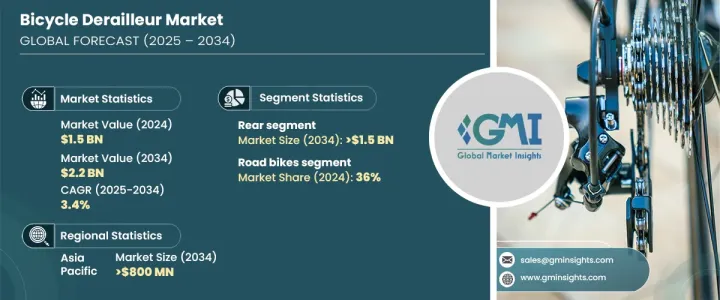
세계의 자전거 변속기 시장은 2024년 15억 달러로 평가되었고, 2025년부터 2034년까지 연평균 성장률(CAGR)은 3.4%를 나타낼 전망입니다.
이러한 성장은 사이클링 성능을 혁신하고 있는 전자 변속 및 무선 시스템과 같은 구동계 기술의 혁신이 주도하고 있습니다. 이러한 첨단 시스템은 탁월한 정밀도와 신뢰성을 제공하여 경기 선수와 동호인 사이클리스트 모두에게 전반적인 사용자 경험을 향상시킵니다. 탄소 섬유와 같은 경량 소재와 내구성이 뛰어난 디자인은 성능을 더욱 향상시켜 다양한 라이더에게 어필하고 있습니다.

피트니스, 레크리에이션, 친환경 출퇴근을 위한 자전거가 지속적으로 인기를 얻으면서 고성능 자전거 부품에 대한 수요도 빠르게 증가하고 있습니다. 특히 정부 보조금과 자전거 인프라 확충에 힘입어 e-bike(전기 자전거)의 부상이 시장 확대에 기여하고 있습니다. e-bike의 도입이 가속화되면서 효율적이고 내구성이 뛰어난 구동계 시스템에 대한 필요성이 더욱 부각되고 있습니다. 또한 산악 자전거와 경쟁적인 사이클링에 대한 열기가 높아지면서 최첨단 기어 변속 기술에 대한 수요가 증가하여 현대 사이클리스트에게 필수적인 요소가 되었습니다.
| 시장 범위 | |
|---|---|
| 시작 연도 | 2024년 |
| 예측 연도 | 2025-2034년 |
| 시작 금액 | 15억 달러 |
| 예측 금액 | 22억 달러 |
| CAGR | 3.4% |
시장 세분화에서 시장은 전방 변속기와 후방 변속기로 나뉘며, 후방 변속기는 2024년에 66%의 점유율을 차지하며 시장을 선도했습니다. 후방 변속기는 전자 변속 및 무선 시스템과 같은 첨단 기술을 점점 더 많이 통합하여 더 부드럽고 정밀한 기어 전환을 제공하고 있습니다. 탄소 섬유와 같이 더 가볍고 강한 소재의 채택은 특히 경쟁이 치열한 사이클리스트의 성능을 더욱 향상시키고 있습니다. 또한, 특히 산악 자전거와 그래블 자전거에서 1x 구동계가 증가하면서 내구성이 뛰어난 고성능 후방 변속기 시스템에 대한 수요도 증가하고 있습니다.
자전거의 유형별로 보면, 2024년 시장 점유율은 로드 자전거가 36%를 차지하고 있습니다. 사이클리스트들이 성능과 속도를 극대화하기 위해 탄소 섬유와 같은 경량 소재의 인기가 높아지고 있습니다. 또한, 1× 구동계와 더 넓은 기어 범위로의 전환은 사이클리스트가 다양한 지형에 대처할 수 있는 능력을 향상시켜 장거리 라이딩에서 더 큰 활용성과 편안함을 제공합니다.
아시아태평양에서는 자전거 변속기 시장이 2024년에 37%의 점유율을 차지했으며, 2034년까지 8억 달러를 창출할 것으로 예측되고 있습니다. e-bike의 채용이 급증함에 따라 고성능 구동계 부품에 대한 수요도 크게 증가하고 있습니다.
The Global Bicycle Derailleur Market, valued at USD 1.5 billion in 2024, is poised for steady growth with a projected CAGR of 3.4% from 2025 to 2034. This growth is driven by innovations in drivetrain technologies, such as electronic shifting and wireless systems, which are revolutionizing cycling performance. These advanced systems offer unmatched precision and reliability, enhancing the overall user experience for both competitive and recreational cyclists. Lightweight materials like carbon fiber and durable designs further elevate performance, appealing to a broad range of riders. The increasing adoption of e-bikes is also a key factor, creating a surge in demand for derailleur systems that can withstand higher torque levels, ensuring optimal functionality across various bicycle categories.

As cycling continues to gain popularity for fitness, recreation, and eco-friendly commuting, the demand for high-performance bicycle components is growing rapidly. The rise of electric bicycles (e-bikes), supported by government subsidies and the expansion of cycling infrastructure, is especially contributing to the market's expansion. With e-bike adoption gaining momentum globally, the need for efficient, durable drivetrain systems has become more pronounced. Furthermore, the increasing enthusiasm for mountain biking and competitive cycling has spurred the demand for cutting-edge gear-shifting technologies, making them essential for the modern cyclist.
| Market Scope | |
|---|---|
| Start Year | 2024 |
| Forecast Year | 2025-2034 |
| Start Value | $1.5 Billion |
| Forecast Value | $2.2 Billion |
| CAGR | 3.4% |
In terms of product segmentation, the market is divided into front and rear derailleurs, with the rear derailleur segment leading the market by holding a 66% share in 2024. This segment is expected to continue its growth trajectory, reaching USD 1.5 billion by 2034. Rear derailleurs are increasingly incorporating advanced technologies like electronic shifting and wireless systems, providing smoother and more precise gear transitions. The adoption of lighter, stronger materials, such as carbon fiber, is further driving performance, particularly for competitive cyclists. Additionally, the rise of 1x drivetrains, especially in mountain and gravel bikes, is increasing the demand for durable, high-performance rear derailleur systems.
When broken down by bicycle type, road bikes accounted for 36% of the market share in 2024. Road bikes are adopting cutting-edge electronic and wireless shifting systems that allow for effortless gear transitions. As cyclists seek to maximize performance and speed, lightweight materials like carbon fiber are becoming increasingly popular. The shift towards 1x drivetrains and wider gear ranges also enhances a cyclist's ability to tackle diverse terrains, offering greater versatility and comfort on long rides.
In the Asia Pacific region, the bicycle derailleur market held a 37% share in 2024 and is projected to generate USD 800 million by 2034. China, in particular, is witnessing growing demand for both traditional bicycles and e-bikes, driven by rapid urbanization and government policies that promote sustainable transportation options. The surge in e-bike adoption has significantly increased the need for high-performance drivetrain components. Additionally, a growing middle-class population is pushing for more advanced yet affordable derailleur systems, leading to increased competition and innovation among local manufacturers.